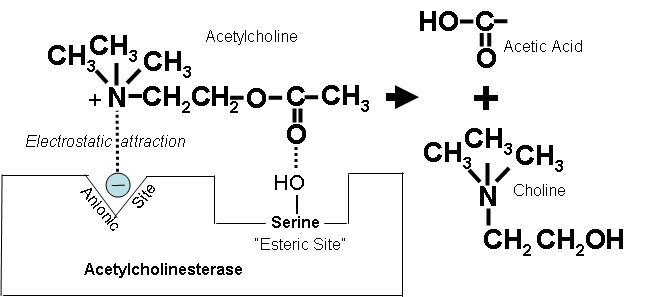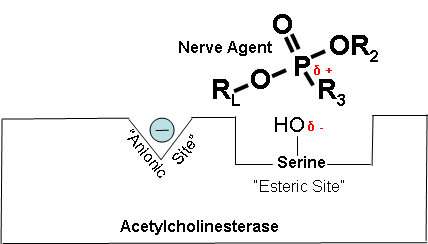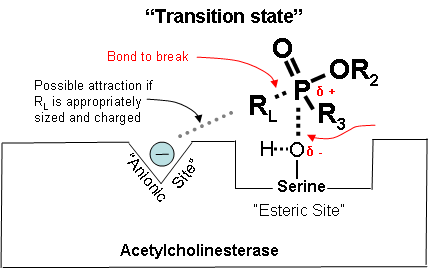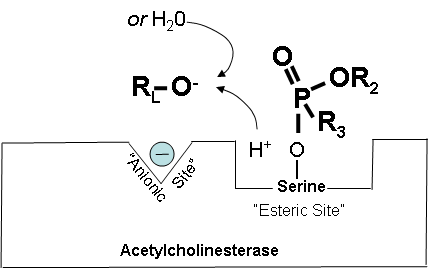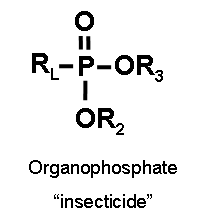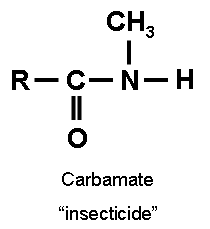Cholinesterase Inhibitors: Including Insecticides and Chemical Warfare Nerve Agents
Part 2: What are cholinesterase inhibitors?
Course: WB 1098
CE Original Date: October 16, 2007
CE Renewal Date: October 16, 2010
CE Expiration Date: October 16, 2012
Download Printer-Friendly version [PDF - 1.88 MB]
| Previous Section | Next Section |
Learning Objectives |
Upon completion of this portion of the case study, you should be able to:
|
|||||||||||||||
The Primary Toxic Effect of Cholinesterase Inhibitors |
Acetylcholinesterase inhibitors (which, for brevity, we will refer to as cholinesterase inhibitors) are chemicals whose primary toxic effect is to block the normal breakdown of the neurotransmitter, acetylcholine. This normal breakdown is shown in Figure 1 below. |
|||||||||||||||
Breakdown of Acetylcholine by Cholinesterase (Optional Reading) |
Figure 1. Breakdown of acetylcholine. |
|||||||||||||||
Breakdown of Acetylcholine (Optional Reading) |
They do this by occupying and blocking the site where the neurotransmitter, acetylcholine, attaches to the enzyme, acetylcholinesterase. If you are interested in the details at the chemical level, see the Optional Reading below. |
|||||||||||||||
How Acetylcholine is Blocked (Optional Reading) |
Figure 2 below shows how a cholinesterase inhibitor (in this case, a nerve agent) attaches to the serine hydroxyl group on acetylcholinesterase. This prevents acetylcholine from interacting with the cholinesterase enzyme and being broken down. δ + Indicates that phosphorus is partially electropositive. δ – Indicates that oxygen is partially electronegative. Diagrams modified from Wiener, S. W., and R. S. Hoffman. "Nerve Agents: A Comprehensive Review." Journal of Intensive Care Medicine 19, no. 1 (2004): 22-37. |
|||||||||||||||
Attraction of Cholinesterase Inhibitor to Acetylcholinesterase (Optional Reading) |
Figure 2. Partially electropositive phosphorus is attracted to partially electronegative serine. |
|||||||||||||||
Molecular Bond Changes (Optional Reading) |
Figure 3. Transition state showing which bonds break and which ones form. |
|||||||||||||||
Cholinesterase Inhibitor Attached to Cholinesterase (Optional Reading) |
Figure 4. Cholinesterase inhibitor attached to acetylcholinesterase preventing the attachment of acetylcholine. |
|||||||||||||||
Effects of Blocked Acetylcholine Breakdown |
This leads to the build up of excessive levels of the neurotransmitter, acetylcholine, at the skeletal neuromuscular junction and those synapses where acetylcholine receptors are located Thus, the primary manifestations of acute cholinesterase inhibitor toxicity are those of cholinergic (neurotransmitter) hyperactivity. (Carlton, Simpson et al. 1998) |
|||||||||||||||
Other Effects of Cholinesterase Inhibitors (Optional Reading) |
There are also other delayed and chronic pathological effects of inhibitors of the cholinesterase enzyme which are less well understood. Cholinesterase inhibitors can have effects on a variety of non-cholinesterase enzymes and neurotransmitters, as well. (Somani and Husain 2001) However, the significance of these effects is not well understood. |
|||||||||||||||
Review of Definitions |
Acetylcholine: a chemical neurotransmitter found widely in the body. It triggers the stimulation of post-synaptic nerves, muscles, and exocrine glands. Acetylcholinesterase (generally referred to as cholinesterase): an enzyme that rapidly breaks down the neurotransmitter, acetylcholine, so that it does not over-stimulate post-synaptic nerves, muscles, and exocrine glands. Acetylcholinesterase inhibitor (generally referred to as cholinesterase inhibitor): a chemical that binds to the enzyme, cholinesterase, and prevents it from breaking down the neurotransmitter, acetylcholine. With toxic doses, the result is that excessive levels of the acetylcholine build up in the synapses and neuromuscular junctions and glands. |
|||||||||||||||
Two Classes of Cholinesterase Inhibitors |
Two classes of cholinesterase inhibitors are organophosphorus compounds and carbamates. The key differences are listed in the table below. (Erdman 2004)
|
|||||||||||||||
Key Points |
|
|||||||||||||||
Progress Check |
| Previous Section | Next Section |
